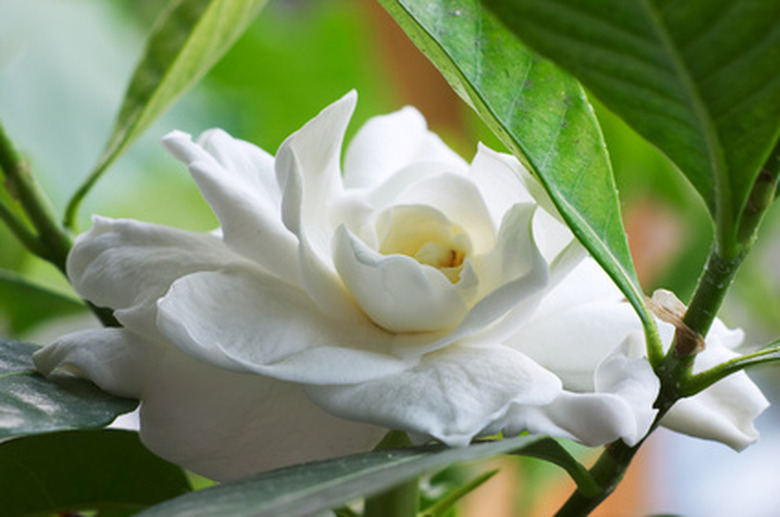Spider Mites On White Gardenias
The gardenia is coveted by gardeners for its lush, deep green foliage and sweet-scented, waxy white blossoms. The plant grows outdoors in USDA hardiness zones 6 to 10. It prefers ample sunlight and high humidity (above 60 percent). It will not tolerate a temperature that dips below 50 degrees F. Often grown indoors as a small, compact houseplant, the gardenia may require a humidifier to grow well. Inadequately cared-for gardenias often suffer pest problems from the spider mite.
Basics
Spider mites (Tetranychus urticae) belong to the arachnid insect family. Spiders, ticks and scorpions belong to the same family. Common colors are red, black, brown and green. The insects are very tiny and look like the head of a pin. It is estimated that they measure about 0.06 inch in size. They have four tiny legs on each side of their body, which is similar in appearance to a spider. A gardenia infected with the pests will exhibit yellowing leaves with a spotted appearance, fine spider webbing, curling of the foliage and even leaf loss. Blossoming may become stunted or non-existent in a severe infestation.
Humidity Requirements
Spider mite infestation occurs year-round indoors, as well as outdoors during the hot, dry summer months. Gardenias planted in humid regions suffer from the infestations far less often than ones in dry regions of the country. The lack of humidity in the air appears to be why spider mite infestations are often more severe on gardenias grown indoors. The insects prefer a humidity of less than 60 percent, and they like the temperature to hover at 85 degrees F, in order to thrive and breed.
Feeding
Under the leaves and along the gardenia's stems are the most common areas to find spider mites clustered. The insects suck the sap from the plant using their powerful mouths. Their voracious feeding causes bruising on the plant. The bruises appear as tiny yellow dots on the plant's leaves. In a heavy infestation, the leaf will take on a spotted look before turning completely yellow and falling from the gardenia.
Life Cycle
The spider mite lays eggs under the leaves of the gardenia. A female lays 100 to 200 eggs. The fine webbing that the mites create help to camouflage and hide the tiny eggs. Egg gestation lasts only a few days, and then the larvae hatch. After the larvae stage, the insects will enter several nymph stages before reaching adulthood. The entire cycle takes place in less than 14 days. Once the spider mite reaches adulthood in 14 days, the eggs are laid and the life cycle repeats. The adult will live only 25 to 26 days before it dies. During all stages of the insect's life, it feeds heavily on the gardenia.
Control
Control of spider mites on the gardenia entails washing the plant with a heavy stream of water to remove the eggs, mites and webbing. Once the infestation is removed, watch closely for any further signs that the mites have returned. Promptly wash the plant again if the mites re-infest it. Raise the humidity level to over 60 percent inside the house to keep mites at bay using a humidifier near the gardenias. Insecticidal control methods are also available from garden supply stores.
False Spider Mites
Gardenias often suffer from infestations with an insect that appears to be a spider mite (Tenuipalpidae). The insects are visually similar, but the plant will have no signs of webbing on its foliage. The mites feed on the plant in the same fashion as the spider mite, and often produce the exact same damage. They frequently pose a problem in both humid and dry regions of the country. Control by washing the mites off the gardenia using water and an insecticidal soap, following directions on the label.
